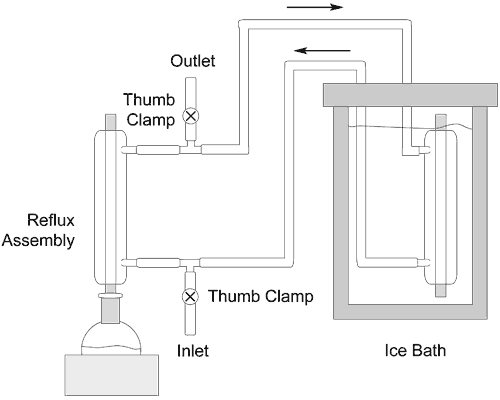(Chief Bee)
09-10-03 00:53
No 457991
(Rated as: excellent)
Using Ice-Cooled Condensers in Chemistry Laboratory
Sally Solomon, Bryan Brook, Susan Rutkowsky, and Joseph Bennet
J. Chem. Educ. 80, 299 (2003) (../rhodium/pdf /ice-cooled.c
Abstract
An ice-cooled condenser, consisting of a jacket built around a tube open to the atmosphere with an outlet for removal of melting ice, is designed for use in academic laboratory classes. The apparatus can be used in place of standard water cooled condensers in setups where refluxing or distillation is performed. With this simple, inexpensive device there is no need for access to running water. Potential flooding due to insecure tubing is no longer a problem. The ice-cooled accessory, produced with standard glass tubing and either 14/10 or 14/20 ground glass joints, is compatible with most commercially available microscale or small scale kits. The device may even be used with an Erlenmeyer flask and a stopper or cork. Two experiments using ordinary household chemicals are suggested, one requiring refluxing and the other distillation.
(Chief Bee)
06-11-04 18:15
No 512805
(Rated as: excellent)
Flood Prevention by Recirculating Condenser Cooling Water
Fraser F. Fleming and Pravin S. Iyer
Journal of Chemical Education 78(7), 946 (2001)
Small-scale reactions performed at reflux temperatures invariably use water-cooled condensers1. Cooling water from municipal suppliers is particularly prone to variations in both temperature and pressure, with potentially detrimental consequences2. Our effort to overcome this problem led us to develop a simple, cost-effective, self-circulating system that uses convection to cool a reflux condenser.
The technique entails connecting the reflux condenser in parallel with another condenser that is immersed in an ice-bath (Fig. 1). The reflux condenser inlet and outlet are each connected to a T-connector and are linked together by a section of tubing about a meter in length. This tubing is connected to a second condenser that is placed inside a two-liter insulated flask (cooler). Efficient cooling requires the complete exclusion of air bubbles, which is readily achieved by filling the system with water through the lower T-connector. When the system is completely filled with water the inlet and outlet tubing is sealed with a thumb clamp and the insulated bath is then filled with ice.
We have experienced uniformly excellent results with this cooling system. Refluxing reactions have been cooled over extended periods (24–48 hours) for solvent volumes as low as 10 mL to as high as 250 mL in a variety of solvents (THF, acetone, ethyl acetate, chloroform, and water). Independent testing of this system established that the cooling method is effective for both refluxing reactions and Soxhlet extraction. The method tolerates different tube lengths (1–2 m) and height differences (±15 cm) between the cooler and the condenser. The only imperative is the complete exclusion of air bubbles and the use of tightly fitting tubing that does not leak. The cooling is remarkably efficient and offers several advantages over conventional water circulation: flooding is effectively prevented, water shut-off systems are not necessary, the equipment is inexpensive, and the use of large volumes of water is avoided.

Figure 1. Diagram of the cooling system.
Literature Cited
1. Vogel, A. I. Vogel’s Textbook of Practical Organic Chemistry, Including Qualitative Organic Analysis; Longman: London, 1978; p 63.
2. Conlon, D. R. J. Chem. Educ. 1966, 43, A589.
The Hive - Clandestine Chemists Without Borders
(Stoni's sexual toy)
06-12-04 00:08
No 512861
That must be pretty big bore rubber hose if they expect it to work without a circulating pump.
BUSH/CHENEY 2004! After all, it ain't my country!
www.american-buddha.com/addict.war.1.htm
(Hive Bee)
06-12-04 05:34
No 512907
So Osmium, in your opinion, what would you consider to be the most suitable tubing for this setup?
This is great news, it couldnt have come at a better time for me, I recently lost my 240v water circulating pump to a damn power surge!
Apparently, SWIM is so excited about this, hes off to steam some meth right now
Of course, I will let everyone know how SWIM goes!
Cheers Rhodium, muchly appreciated my friend
I'm a diamond that is tired, of all the faces i've aquired.
(Guardian)
06-12-04 19:41
No 513004
I use almost the exact same closed system as described, in order to keep soxhlets running for long extractions where I might not be in the lab for over 24hrs, and would prefer not to return to a flooded lab, or evaporated solvent. The only difference is I use a peristaltic pump in-between the cooler and and the soxhlet in order to keep the water circulating. I never put much thought into making it re-circulate without the peristaltic pump. That seems quite interesting
regards,
methyl_ethyl
Unipolar Mania, It's good for life...
(Hive Bee)
06-12-04 23:35
No 513035
P had an insulated icebox,with the drain at the bottom.Hydroponics pump (designed to run 24/7/365).Half full of ice water, a few big blocks of ice with the lid loosely on and P could distill all day and still have damn cold water left.